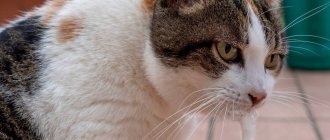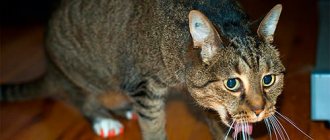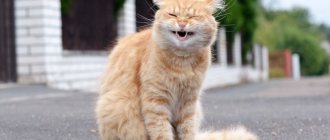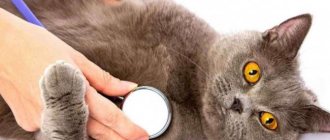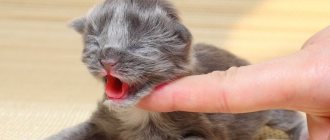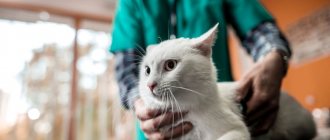We all cough from time to time. The same is true for animals. Coughing is a reflex due to which unnecessary substances are eliminated through the respiratory tract.
Cats cough when something irritates their receptors located in the nasopharynx (the area behind the nose and mouth), larynx, trachea and bronchi. If your pet's coughing is irregular, then the owner has nothing to worry about. A chronic or severe cough, as well as one that is accompanied by a change in the animal’s condition, requires attention.
A furry friend who coughs constantly or severely should be taken to the vet. The sooner you contact a specialist, the more correct the diagnosis will be made and treatment prescribed.
Below are the reasons why your cat may be coughing, as well as tips on how you can help your beloved pet.
Why is my cat coughing?
There are many reasons that cause an animal to cough. Sometimes the problem is obvious. For example, you bought a new cat litter box and, without wiping it, gave it to your pet for use. Having climbed into it, the cat coughed. The source of this reaction was dust that irritated the receptors.
A persistent cough can be caused by prolonged exposure to irritants, such as tobacco smoke.
The most common causes of cough in cats are:
- Respiratory infections: Bacterial and viral infections, fungi and parasites can cause a regular cough.
- Asthma : Certain irritants in cats with asthma cause spasms and swelling of the airways, as well as a buildup of mucus, leading to coughing.
- Pleural effusion : The condition is excess fluid that appears near the lungs and exits through the airways.
- Foreign objects : By coughing, your pet can get rid of food particles, grass and other objects caught during inhalations.
- Cancer : If the animal begins to cough regularly, this may be a sign of damage to the respiratory tract due to cancer.
- Trauma : Physical trauma, chemical and thermal burns to the respiratory tract are one of the reasons that causes a cat to cough.
- Heartworms: parasites living in the organs of an animal contribute to the development of cough.
Humans and dogs may cough due to heart disease, but cats most often cough due to respiratory problems.
Symptoms accompanying coughing attacks in a cat
It is easy to determine that a pet is having a coughing attack - the cat presses itself to the floor, arches its back, stretches its neck and retracts its abdominal wall, while simultaneously lowering its head.
After this, the cat’s mouth opens slightly and characteristic sounds are heard. From the outside it looks like she was choking on something. The process may be accompanied by wheezing, gagging and vomiting.
As we have already written, cats are a species that can suppress the cough reflex. Sometimes complex manipulations with body movements help them, and the attack stops.
There are several indirect symptoms that indicate that your cat may be having a coughing fit:
- Snoring or loud snoring accompanies airway congestion. Healthy cats don't snore!
- Wheezing. These sounds appear while you are awake. The cat often wheezes while eating when he tries to swallow it.
- Loss of appetite and weight. If the airways or esophagus are severely irritated, the animal will try to avoid eating. Over time, these symptoms are accompanied by lethargy.
Be attentive to your pets; a cough noticed in time is a guarantee of quick and high-quality treatment.
Wet vs dry cat cough
The range of measures taken by specialists to determine the causes of cough in cats includes a medical history, physical examination and diagnostic tests. At home, owners can independently determine what kind of cough the animal has (wet or dry) and report it to the veterinarian. This information will be useful for making a diagnosis.
Wet is accompanied by the release of sputum - thick mucus that forms in the respiratory tract due to a respiratory infection. Along with sputum, viruses, bacteria and other substances that accumulate in the lungs are removed from the body.
During dry periods, practically no mucus comes out. This condition is more often associated with asthma, foreign objects or particles lodged in the airways, and cancer.
Who is this cough?
Coughing in cats is an involuntary reflexive, jerky, forced, sonorous exhalation. Cough is initiated by the cough center located in the medulla oblongata, which receives signals via the vagus nerve from sensitive sensors (receptors). The largest number of cough receptors are located in the area of the vocal cords, larynx (this is why coughing occurs when food gets into the “wrong throat”) and in the divisions of the trachea and bronchi. Places where cough receptors accumulate are called cough reflexogenic zones.
First of all, coughing is a protective reflex that occurs in the body of all animals as a result of mechanical or chemical irritation of sensitive cough zones. And in many diseases, when coughing promotes the evacuation of mucus, pus and foreign particles from the lumen of the airways, it promotes recovery.
However, a feature of the cough zones located in the trachea and bronchi is that they respond equally to irritation coming from both the respiratory lumen and the reverse, as if outer, surface. That is why cough is a symptom of a disease of both the respiratory tract and the organs and tissues located around them. Therefore, there are very, very many reasons why a cough may appear. And it does not always benefit the body.
In this article we will dwell in detail only on the two most common types of cough - respiratory and cardiac.
Cough in combination with other symptoms
Cough is often accompanied by other symptoms that can serve as indicators in making a diagnosis.
With a sneeze
Coughing along with sneezing is most often a sign of an incipient respiratory disease. An infection localized to the nasal passages causes the cat to sneeze and develop a runny nose. However, some of the liquid does not come out through the nose, but goes down into the throat, causing a cough.
With wheezing
Wheezing is a classic sign of feline asthma; most often they are accompanied by coughing, difficulty and rapid breathing, while the pet’s mouth remains half open.
With hairballs
“Coughing up” hairballs actually has nothing to do with coughing as such; the cat tries to regurgitate the lumps from the digestive tract, rather than expel them through the respiratory tract.
What you need to pay attention to when treating a cough
I remind you once again that a cough is a symptom of a disease, therefore, on the one hand, in order to reduce its intensity, it is necessary first of all to understand the causes of its occurrence. On the other hand, being a protective reaction of the body, a cough can be beneficial and speed up recovery. In other words, in many cases it is not worth fighting a cough to the bitter end with the help of antitussives. Along with recovery from the underlying disease, the cough will also stop.
The exception is a dry, painful cough, which causes severe anxiety in the cat and even attacks of suffocation. In this case, the cough loses its protective nature and requires immediate attention to a veterinarian.
Nature, “creating” the immune system in cats (and other predators), emphasized antibacterial immunity. This is due to the fact that when hunting and fighting for territory, the wild ancestors of our pets very often received infected injuries and wounds. And without good immune protection against bacteria, it is impossible to survive in the wild. But in the “fight” against viruses, cats are still very far from winning. Therefore, bacterial infections of the nasopharynx (and with them the so-called respiratory cough) are much less common in cats than in humans, and develop only against the background of a severe weakening of the immune system (which, as a rule, leads to various viral infections). In this regard, such a concept as a “cold” is not suitable for cats.
Why is my cat coughing up blood?
A pet coughing rarely should not cause concern to the owner, but if the cough is accompanied by blood discharge, this becomes a sign that the animal's health may be in danger.
If your cat is coughing up blood, contact your veterinarian immediately!
The appearance of bloody discharge can be caused by:
- injury;
- cancer that leads to the destruction of blood vessels;
- serious infections;
- toxic substances that interfere with normal blood clotting.
When should I worry?
Your cat's wheezing breathing is nothing to worry about. However, it is important to consult a veterinarian to determine the cause of this condition and provide treatment if necessary.
If you see any of the following symptoms along with wheezing, contact your veterinarian immediately.
- Having difficulty catching my breath
- Cough or choking
- Very pale or bluish gums
- Dripping/collection of mucus in the mouth
- Signs of distress (asthma attack)
- Prolonged wheezing
- Very lethargic
Heart problems
Many people do not know what to do if a cat coughs and wheezes, for what reason this reflex occurs. A serious reason to see a doctor is the occurrence of heart problems. Most often, this disease occurs in old and overweight animals. At first, coughing rarely bothers the animal, but later it inevitably becomes more frequent.
The disease is diagnosed by tactile and visual examination. The pet's blood pressure is measured, electrocardiography and radiography are performed. Such a disease requires lifelong care for the animal and maintenance therapy. Treatment is prescribed by a veterinarian based on the research results obtained. Giving medications at your own discretion is strictly prohibited.
The cat must be provided with rest, proper nutrition and follow the doctor's instructions. For animals with this pathology, special dietary foods are sold in pharmacies.
Basic methods of treating pathologies that cause cough
Putting off visiting a veterinarian if you have a cough and trying to help your pet on your own is dangerous - you may unknowingly make a mistake in diagnosis and start the wrong treatment. You can take independent measures before contacting a veterinarian only if you suspect that the animal is choking. In this case, delay is dangerous, as it can lead to death.
If you see that the cat cannot clear its throat, it begins to experience asphyxia and saliva flows from its mouth, then you need to quickly pick up the animal and carefully open its mouth with your fingers. It is better for several people to participate - one person will hold the animal, illuminate the larynx with a flashlight, and the second will remove the foreign object with fingers or tweezers. If the object in the cat’s throat is not visible, then you need to lower the animal to the floor, lift the back of the cat’s body and at the same time gently squeeze the cat’s chest or tap it between the shoulder blades. If within 3-5 minutes of performing these actions the cat still does not cough or spit out a foreign object, then you cannot do without the help of a doctor - you must find any opportunity to show the animal to a specialist as quickly as possible.
To examine the mouth of a cat that has choked on something, you need to gently press on the cheekbone area with one hand from above, and with the other hand slightly pull the skin under the jaw (you cannot press on the jaw itself with your fingers, as this can lead to a fracture)
If there are no symptoms of asphyxia, a coughing cat should also be seen by a doctor. True, in this case there is no need for emergency hospitalization of the animal (for example, if the cough occurs at night, you can wait to visit the clinic until the morning). After diagnosing and determining the source of the problem, the doctor prescribes the necessary course of treatment.
Therapy is divided into two parts - symptomatic (temporarily improving the cat’s well-being) and eliminating the cause of the malaise. For cough, the animal is given drugs that act on the cough center, blocking the reflex (for example, Sinekod, Bronholitin). Such medications should only be prescribed by a veterinarian and always as part of a comprehensive treatment. For a dry cough, expectorants such as ammonium chloride or salbutamol are given. They provoke the liquefaction and removal of mucus (at first they make the cough worse, but when the mucus comes out, the cat immediately feels better).
The main treatment depends on the diagnosis:
- If the cough is caused by worms, the cat needs a course of anthelmintics: Milbemax, Stronghold, Kanikvantel, etc.
- In the case of an allergic cough, the animal is given Suprastin, Tavegil or other antihistamines. It is imperative to identify the allergen and make sure that the cat no longer comes into contact with it (otherwise it is useless to take medications - attacks will be repeated constantly).
- For infectious pathology, antibiotics are taken (penicillins, cephalosporins, tetracyclines, chloramphenicol, macrolides or other groups of antimicrobial agents - selected depending on the type of pathogen).
- Heart failure is treated with glycosides and potassium preparations. It is imperative to protect your pet from increased physical activity and stress, which are provocateurs for increased cardiac cough.
- Injuries to the larynx require immobilization (rest) of the neck, antibacterial, analgesic, and decongestant therapy. Feeding may be done through a feeding tube to prevent food from irritating the wound.
- Bronchitis and other inflammatory diseases of the respiratory system are treated with broad-spectrum antibiotics (for example, Streptomycin, Erythromycin) and anti-inflammatory drugs.
- When a cat has an asthmatic attack, glucocorticosteroids and bronchodilators (drugs that dilate the bronchi) are prescribed.
In addition to medications, a sick cat needs special care: it needs warmth, rest and proper nutrition (only liquid or soft food is given, as hard pieces will irritate the throat and worsen the cough)
How to treat a kitten's cough
Even isolated cases of coughing in kittens should alert the owner. The immune defense of babies is not able to cope with attacks from viruses and bacteria. The disease in children develops 5 times faster and more complex than in adults; it can have such a rapid course that without timely treatment, the baby will die in less than a couple of days.
A kitten can cough for the same reasons as a large animal. Most often, diseases arise due to improper living conditions (if the “nest” is in a draft, the baby freezes all the time). Infection with a viral disease or worms can occur from a mother cat.
The methods of treating a coughing kitten are identical to the principles of treating an adult cat. But when selecting medications, you need to look at the instructions so that there are no age-related contraindications, and also very carefully measure the dosage depending on the weight of the kitten. It is advisable to add immunostimulants and probiotics (for example, Vetom, Symbolact, Florentin) to the course of treatment, which will strengthen the immune system and improve the absorption of medications taken.
Helminths
Worms that appear in the body irritate the mucous membrane, causing a cough. This is often accompanied by weight loss, vomiting and dandruff. To combat them, the pet is given antihelminthic medications. In severe cases, they are given again a week after the first dose. Delay can lead to problems with the liver, kidneys and even death.
Trichobezoars, coughing up hair
Cats groom themselves by licking their fur coat with their tongue. That, in turn, can enter the digestive organs. The lumps formed there provoke coughing. It doesn't pose a threat. A paste that dissolves lumps or special food will help.
To measure the temperature
Throat injuries
They also irritate the larynx. Sores and ulcers can be a sign of chlamydia, which people can become infected with.
Heart diseases
Cardiac cough gradually intensifies and is accompanied by lethargy, shortness of breath, and heavy breathing. A cardiogram will confirm this version.
Respiratory diseases
These include viral, bacterial, and fungal infections. Immediately the cough is dry and loud. On the second day, sputum separates and he becomes deaf. In addition, nasal discharge, rotting of the eyes, weakness, and increased body temperature appear.
Pneumonia
Pneumonia can develop as a result of hypothermia, characterized by a dry barking cough, wheezing, increased body temperature, weakness, and refusal to eat. It often occurs against the background of other infections. Antibiotics and mucolytic expectorants are used for treatment.
Survey
Features of cat cough
To establish an accurate diagnosis, the doctor will definitely interview the owner about the nature of the cough and its characteristics.
Characteristics of cat cough:
| Occurrence frequency | Rare Frequent Constant |
| Force | Mild coughing Harrowing Exhausting to the point of vomiting |
| Character | Paroxysmal wheezing With wheezing |
| Duration | Acute Protracted Chronic (lasting more than 2 weeks) |
| Type of manifestation | Dry or unproductive without phlegm. Wet or productive with sputum production. This is noticeable because the cat swallows something after clearing its throat. It is rare for sputum to fly out of a cat's mouth when coughing. |
| Appearance time | Morning Afternoon Evening |
When observing your pet, you should try to determine the type of cough based on these parameters, so that you can then tell the veterinarian. It’s better to make a video so that the doctor himself can conduct the assessment.
Infection with worms
A playful kitten becomes lethargic, suffers from diarrhea, uncontrollable vomiting, and constantly tries to cough up if its body is attacked by worms. If affected by worms:
- the pet's belly is enlarged;
- mucus is released with feces;
- The fur becomes dull and dandruff falls out.
Parasites enter the digestive tract of a domestic cat when it feasts on mice, birds, or eats contaminated food. From the intestines, worms travel to the lungs, are swallowed again when coughing, and sexually mature generations lay eggs. To prevent your pet from dying from intoxication, you will need the help of a veterinarian.
First wince when breathing stops
In the most critical situation, when the cat has stopped breathing, it may be necessary to perform artificial respiration and chest compressions. The process is as follows:
- Lay the cat straight, fix its position so that the neck is in a straight line with the spine;
- The animal's mouth must be closed. If necessary, it must be freed from foreign objects, saliva, mucus;
- Exhale air into the animal’s nose through a cupped palm. The frequency of exhalations depends on the size of the cat. It is approximately 20 exhalations per minute. With slight expansion of the chest, the volume of air is considered sufficient;
- Kittens should be given artificial respiration especially carefully so as not to damage their small lungs with a large volume of air;
- In case of cardiac arrest, perform indirect cardiac massage. To do this, press the cat’s chest with your palm with your thumb on one side and the other four on the other. Rhythmically and sharply squeeze and relax your fingers five times in a row, then exhale into the animal’s nose. You should check for a heartbeat every two minutes.
It is necessary to pay attention to any manifestations of hoarse breathing in your pet. With this symptom there are almost always serious health problems present.
How to tell if your cat is choking and not coughing
It is safe to think that the cat has choked if the following picture is observed:
- The cat does not take a characteristic pose (with bent legs, elongated neck).
- There is gagging and wheezing.
- The animal is trying to pull something out of its mouth with its paw. May roll around on the floor and show obvious anxiety.
- Drooling is flowing from the mouth because there is no way to swallow.
This behavior is usually preceded by eating or playing with small objects.
Diagnostics in a veterinary clinic
Diagnosis is based on identifying the cause of the cough. The veterinarian examines the animal and collects anamnesis. The owner must clearly describe the signs, frequency and nature of the cough, highlight some characteristic features, for example, blood, sputum production.
A cough with sneezing may indicate cat flu. If it is accompanied by wheezing, then most likely your pet has asthma. Sputum production coupled with weight loss and diarrhea indicates the possible presence of parasites.
Necessary diagnostic methods include:
- general and clinical blood tests;
- serological blood test;
- Analysis of urine;
- chest x-ray;
- ECG;
- tracheal endoscopy;
- organ biopsy;
- culture of bronchial secretions for microflora.
Until a particular diagnosis is confirmed, the veterinarian prescribes maintenance therapy to relieve coughing attacks.
Respiratory diseases
A common cold can easily provoke coughing, sneezing, swelling of the mucous membranes, and discharge of pus from the nasal passages and eyes. During this period, it is difficult for the pet to swallow, which is why he stops eating and even drinking. Inflamed airways, fortunately, are easy to treat.
Read also: What is the best thing to do after school?
The disease is eliminated with the help of antiviral, antibacterial medications, as well as expectorants or antitussives, which are prescribed depending on the type of cough. To restore and subsequently strengthen the animal’s immunity, the veterinarian prescribes a vitamin complex. As a preventive measure , you should take your cat for vaccination , which will reduce the risk of a serious disease.


